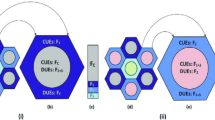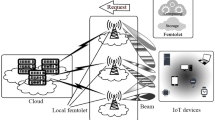Abstract
This paper addresses three prime issues of fifth generation mobile network: frequency allocation, power efficiency and communication while computing. This paper proposes a power-efficient micro-femtolet/macro-femtolet network based on soft fractional frequency reuse. Macrocell/microcell base stations are used in the network, and for providing good signal strength and offloading facilities to indoor and edge region users’ femtolets are allocated inside the macrocell/microcell. The power transmission in the proposed heterogeneous network (HetNet) is estimated. The analytical evaluation presents that use of SFFR reduces the power transmission of the network by 10.87% approximately. This is also observed that the signal-to-interference-plus-noise ratio (SINR) of the network is improved using the proposed strategy. For experimental evaluation we have used vector signal generator (VSG) and vector signal analyzer (VSA). The simulation analyses performed using network simulator Qualnet shows that femtolet provides \(\sim\)(2–34)% reduction in energy consumption than the cloud based offloading.











Similar content being viewed by others
References
Obi, E., Usman, A. D., Sani, S. M., Momodou, A., & Tekanyi , S. (2020). Development of a hybrid algorithm for user association and resource allocation to improve load balancing and energy efficiency in 5g hetnet. ELEKTRIKA-Journal of Electrical Engineering, 19(1), 17–25.
Jeyakumar, P., Malar, E., Niveda, S., & Muthuchidambaranathan, P. (2021). Optimal microwave wireless backhaul link design using a massive mimo for 5g hetnet-practical deployment scenario. Wireless Personal Communications. https://doi.org/10.1007/s11277-021-08543-8
Xu, Yongjun, Gui, Guan, Gacanin, Haris, & Adachi, Fumiyuki. (2021). A survey on resource allocation for 5g heterogeneous networks: Current research, future trends and challenges. IEEE Communications Surveys & Tutorials, 23(2), 668–695.
Ghosh, Subha, & De, Debashis. (2021). E2m3: Energy-efficient massive mimo-miso 5g hetnet using stackelberg game. The Journal of Supercomputing. https://doi.org/10.1007/s11227-021-03809-1
Mukherjee, Anwesha, De, Debashis, & Roy, Deepsubhra Guha. (2016). A power and latency aware cloudlet selection strategy for multi-cloudlet environment. IEEE Transactions on Cloud Computing, 7(1), 141–154.
Maghsudi, Setareh, & Niyato, Dusit. (2017). On power-efficient planning in dynamic small cell networks. IEEE Wireless Communications Letters, 7(3), 304–307.
Deb, Priti, Mukherjee, Anwesha, & De, Debashis. (2018). A study of densification management using energy efficient femto-cloud based 5g mobile network. Wireless Personal Communications, 101(4), 2173–2191.
Mukherjee, Anwesha, & De, Debashis. (2016). Femtolet: A novel fifth generation network device for green mobile cloud computing. Simulation Modelling Practice and Theory, 62, 68–87.
Fereydooni, Mehdi, Sabaei, Masoud, Dehghan, Mehdi, Eslamlou, Gita Babazadeh, & Rupp, Markus. (2018). Analytical evaluation of heterogeneous cellular networks under flexible user association and frequency reuse. Computer Communications, 116, 147–158.
Mukherjee, Anwesha, De, Debashis, & Deb, Priti. (2016). Interference management in macro-femtocell and micro-femtocell cluster-based long-term evaluation-advanced green mobile network. IET Communications, 10(5), 468–478.
Kim, Donghee, Ahn, Jae Young, & Kim, Hojoon. (2011). Downlink transmit power allocation in soft fractional frequency reuse systems. ETRI Journal, 33(1), 1–5.
Mukherjee, Anwesha, Deb, Priti, & De, Debashis. (2020). Lfmtcn: A green ultra-dense multi-tier small cell network using leader-follower strategy. Wireless Personal Communications, 110(1), 275–289.
Mukherjee, Anwesha, Deb, Priti, De, Debashis, & Obaidat, Mohammad S. (2019). Wma-mifn: A weighted majority and auction game based green ultra-dense micro-femtocell network system. IEEE Systems Journal, 14(1), 353–362.
Tseng, Chih-Cheng., & Peng, Ching-Shun. (2018). Co-tier uplink interference management by stackelberg game with pricing in co-channel femtocell networks. Wireless Personal Communications, 100(1), 7–23.
Attia, Eman S., El-Dolil, Sami A., & Abd-Elnaby, Mohammed. (2018). Spectrum allocation for enhanced cross-tier interference mitigation with throughput improvement for femtocells in a heterogeneous lte cellular network. Wireless Personal Communications, 101(3), 1671–1683.
Chandrasekhar, Vikram, Andrews, Jeffrey G., & Gatherer, Alan. (2008). Femtocell networks: A survey. IEEE Communications Magazine, 46(9), 59–67.
Wang, Xiaofei, Vasilakos, Athanasios V., Chen, Min, Liu, Yunhao, & Kwon, Ted Taekyoung. (2012). A survey of green mobile networks: Opportunities and challenges. Mobile Networks and Applications, 17(1), 4–20.
Mukherjee, Anwesha, Bhattacherjee, Srimoyee, Pal, Sucheta, & De, Debashis. (2013). Femtocell based green power consumption methods for mobile network. Computer Networks, 57(1), 162–178.
Mhiri, F., Reguiga, KSB., Bouallegue, R., Pujolle, G., (2011). A power management algorithm for green femtocell networks. In: 2011 The 10th IFIP Annual Mediterranean Ad Hoc Networking Workshop, IEEE. pp. 45–49.
Al Haddad, M., & Bayoumi, M., (2015). Green novel power control framework for dense femtocell grids. In: International Conference on Computer Vision and Image Analysis Applications, IEEE, pp. 1–6.
Lee, P., Lee, T., Jeong, J., & Shin, J. (2010). Interference management in lte femtocell systems using fractional frequency reuse. In: 2010 The 12th international conference on advanced communication technology (ICACT), IEEE, vol 2 (pp. 1047–1051).
Kang, Xin, Zhang, Rui, & Motani, Mehul. (2012). Price-based resource allocation for spectrum-sharing femtocell networks: A stackelberg game approach. IEEE Journal on Selected areas in Communications, 30(3), 538–549.
Saquib, Nazmus, Hossain, Ekram, Le, Long Bao, & Kim, Dong In. (2012). Interference management in ofdma femtocell networks: Issues and approaches. IEEE Wireless Communications, 19(3), 86–95.
Sharma, Nitin, Badheka, Divyakumar, & Anpalagan, Alagan. (2014). Multiobjective subchannel and power allocation in interference-limited two-tier ofdma femtocell networks. IEEE Systems Journal, 10(2), 544–555.
Chai, Xiaomeng, Zhang, Zhongshan, & Long, Keping. (2015). Joint spectrum-sharing and base station sleep model for improving energy efficiency of heterogeneous networks. IEEE Systems Journal, 12(1), 560–570.
Ghosh, J., & Jayakody, D. N. K. (2018). An analytical view of ase for multicell ofdma networks based on frequency-reuse scheme. IEEE Systems Journal, 14(1), 645–648.
Ghosh, Subha, De, Debashis, & Deb, Priti. (2019). Energy and spectrum optimization for 5g massive mimo cognitive femtocell based mobile network using auction game theory. Wireless Personal Communications, 106(2), 555–576.
Othman, Mazliza, Khan, Abdul Nasir, Shuja, Junaid, Mustafa, Saad, et al. (2017). Computation offloading cost estimation in mobile cloud application models. Wireless Personal Communications, 97(3), 4897–4920.
Pandey, Vikas, Singh, Shashank, & Tapaswi, Shashikala. (2015). Energy and time efficient algorithm for cloud offloading using dynamic profiling. Wireless Personal Communications, 80(4), 1687–1701.
Mukherjee, A., De, D., & Buyya, R. (2019). E2r–f2n: Energy-efficient retailing using a femtolet-based fog network. Software: Practice and Experience, 49(3), 498–523.
Deb, P., Mukherjee, A., & De, D. (2019). Design of green smart room using fifth generation network device femtolet. Wireless Personal Communications, 104(3), 1037–1064.
Mukherjee, Anwesha, Deb, Priti, De, Debashis, & Buyya, Rajkumar. (2018). C2of2n: A low power cooperative code offloading method for femtolet-based fog network. The Journal of Supercomputing, 74(6), 2412–2448.
Roy, D. G., Mukherjee, A., De, D., & Srirama, S. N. (2019). Practical implementation of femtolet based peer-to-peer network. Wireless Personal Communications, 108(4), 2477–2498.
Author information
Authors and Affiliations
Corresponding author
Additional information
Publisher's Note
Springer Nature remains neutral with regard to jurisdictional claims in published maps and institutional affiliations.
Rights and permissions
About this article
Cite this article
Mukherjee, A., Deb, P. & De, D. Femtolet Based Low Power Hetnet Using Soft Fractional Frequency Reuse. Wireless Pers Commun 121, 2529–2544 (2021). https://doi.org/10.1007/s11277-021-08835-z
Accepted:
Published:
Issue Date:
DOI: https://doi.org/10.1007/s11277-021-08835-z




